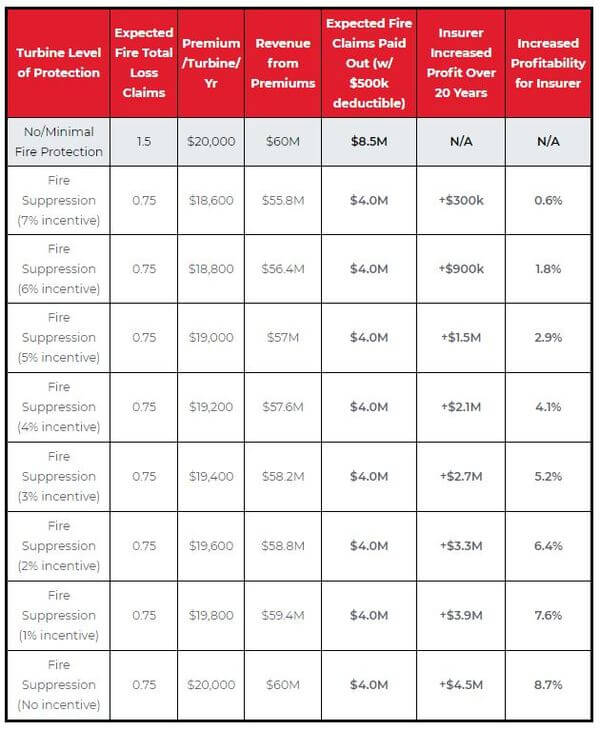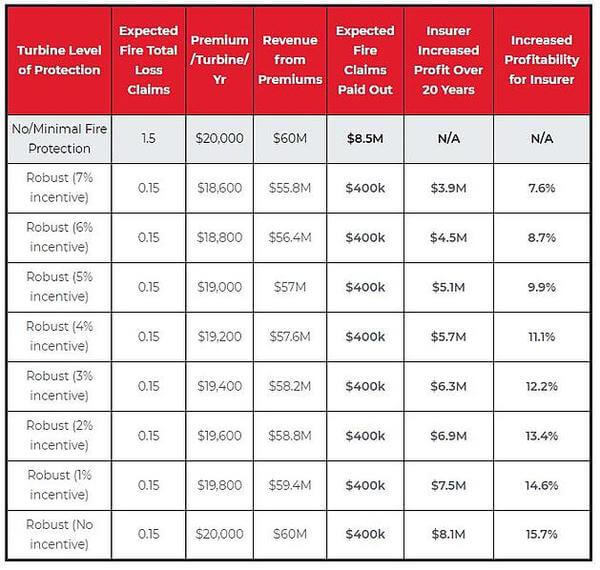Prevent Insurance Rates from Increasing After a Wind Turbine Fire
The importance of wind turbine insurance
Wind turbine insurance is meant for sudden and unforeseen losses. As the cost of wind turbine fires is on the rise, reaching as high as $7-8 million, that’s not a line item you want on your balance sheet. Wind turbine insurance is crucial for the profitability of the industry. If you have a turbine fire that causes your premiums to increase, or worse, a restriction in coverage, it can negatively affect your entire business.
To understand how to please your insurer after a fire, you must first understand their business goals. Insurance businesses make their money by collecting premiums and minimizing the amount of money they pay out on claims. Considering a wind turbine fire can cost up to $8 million, it can wipe out any profits from having a policy with you. Many insurers and brokers have invested in hiring risk engineers and performing fire surveys to ensure that they are opening policies with projects that have minimized risk.
What happens after a fire?
A wind turbine fire can cause months of aggravations. Root cause analysis investigations, negative news coverage, and replacing the destroyed turbine are painful parts of the long process to get a replacement turbine generating revenue. Also, premiums typically increase with high deductibles after a wind turbine fire, and you can get sticker shock when you see how much your risk exposure and pricing have changed after a single fire event.
Avoiding addressing the risk of fire in a turbine can be an expensive mistake, especially if your underwriters aren’t ignoring it.
What factors affect your risk?
Underwriters look at several factors when developing your risk score. It changes per underwriter, but it can include:
- Location
- Deductibles
- Claims history
- Turbine manufacturer
- Wildfire concerns
- Quality of operations and maintenance
- Age of turbines
Anything that makes your turbines more likely to catch on fire or more likely to cause damage to surrounding land will increase your risk.
How your insurance policy changes after a fire
What changes can you expect to see on your insurance policy when it comes time for renewal? It depends on the underwriter. There are three main changes you can see to your policy after a fire claim.
- Increased premiums
- Increased deductibles
- Restrictions in cover
All these changes can harm the profitability of your operations. Premium increases are a direct hit to your bottom line. Increased deductibles can cause any future insurance claims to be worth less. A restriction in your coverage can mean you get less money from insurers on future claims or even no money at all.
If your turbines are seen as a high fire risk, you may have difficulty finding an insurance company that will agree to cover you unless you prove you can mitigate the risk of fire loss. There are preemptive actions you can take to prove to insurers that your turbines are insurable assets.
Steps to make your insurance policy more favorable
Actions you do or don’t take can affect how safe your project seems to an insurer. We’ll discuss a few ways to proactively combat an increase in premiums, deductibles, and restrictions in cover due to fire risk.
Installing fire suppression systems
Fire suppression systems are “critical to the insurance industry’s profitability in underwriting renewable energy risks,” according to Jatin Sharma, Managing Partner at NARDAC. When a fire does start, these systems can automatically detect and suppress the fire in a matter of seconds. This means that you can have your turbine running as early as the next day instead of suffering from a year or more of downtime, increased insurance rates, and millions of lost dollars.
Underwriters have been reticent in the past about giving discounts or provisions for similar technology. However, underwriters may be open to adjusting policies with the hardened market and increased fires if you can prove you are actively addressing your fire risk by implementing fire suppression systems.
Sharma added, “from an underwriting capital point of view, it’s only a matter of time before [fire suppression] becomes a minimum requirement in order to insure [wind turbines].” Fire suppression systems substantially reduce the claims risk to insurers, making your project more appealing to them than ones without fire suppression.
Performing loss control inspections
A loss control inspection helps to understand which components are risky in your turbines. Simply understanding the risks is not enough. Showing that you are mitigating the risks called out is a sign to underwriters that you are proactively minimizing the risk of a loss. Communicating your loss mitigation measures makes your policy more favorable.
Ensuring compliance to OEM policies and improving preventative maintenance plans
Nobody knows your turbines and their risks better than the original equipment manufacturers (OEMs) themselves. They create policies to ensure that they operate smoothly for their expected lifecycle. Because wind turbines are running nearly continuously for up to 20 years, any slight defects can lead to significant issues and increased risks.
If a fire occurs in one of their turbines, it hurts their reputation as much as it does yours. By clearly showing how you follow OEM plans, you can prove to insurers that you are keeping proper care of your turbines and minimizing fire risk.
Improving vegetation management
A turbine fire isolated to a single turbine can cost a few million dollars. A turbine fire that starts a wildfire can cost over a billion dollars, as we have seen with other energy providers. Vegetation management is a crucial activity to minimize the risk of a wildfire spreading and creating a secondary peril.
Communicating the value of mitigation measures to your underwriters
For all fire risk mitigation measures you take, it is essential to communicate that to your insurer, more now than ever. How else do underwriters know what steps you’re taking to reduce claims they would have to pay out? This helps to make your business standout over others and gain a more favorable policy as a result.
When you install a fire detection and suppression system, you mitigate the risk of loss due to fire. If your fire suppression systems are 100% effective in mitigating 50% of the expected fires as you are not installing them to prevent lightning strikes and some arc flashes, the expected financial benefits to an insurer for a 150 turbine wind farm are shown in the table below. For simplicity, we will ignore business interruption claims.

When you also have lightning protection systems and arc flash systems, in addition to fire suppression systems and a comprehensive maintenance plan, we will assume you mitigate the risk of a total loss in 90% of fires. The financial benefits to insurers now look like this:

If you are installing robust fire protection, including fire detection and suppression, arc flash, and lightning protection systems, then you are minimizing your risk while reducing exposure for large payouts for the insurer. If they give you no incentive for adding these risk mitigation efforts, then they are potentially improving their profitability by $8.1M or 15.7% over a 20-year lifespan of your turbines. By giving a 7% incentive on your policy, you see reductions in your premiums, and they could still be netting an extra $3.9M or 7.6% in profit over a 20-year lifespan.
From the numbers above, incentivizing the installations of fire protection systems benefits both the insurers and the insured.
Benefits of lower premiums and deductibles
What businesses don’t like having is less money. With more cash to leverage from reduced premiums, your business can continue to grow and invest in revenue-generating assets, like additional turbines and employees, as well as other safety or weatherization measures.
Wind turbine insurance has become more expensive than ever. Being proactive towards risk mitigation and communicating the value to underwriters is key in keeping insurance costs down and avoiding headaches and negative PR.
- Source:
- FireTrace
- Author:
- Press Office
- Link:
- www.firetrace.com/...
- Keywords:
- Firetrace, wind turbine, fire, insurance, policy, insurance rate, security, wind farm, installation, OEM, detetction, lightning protection


























